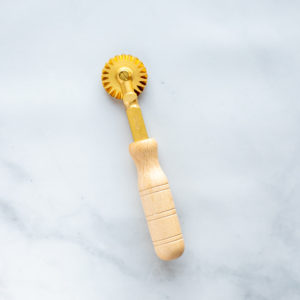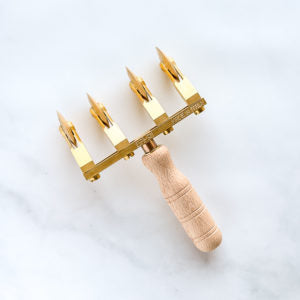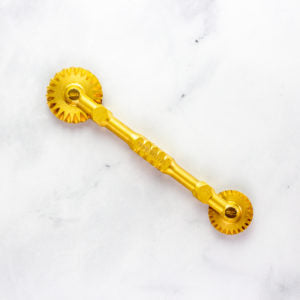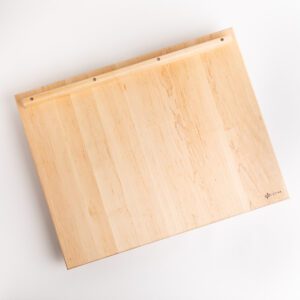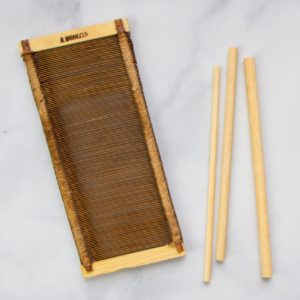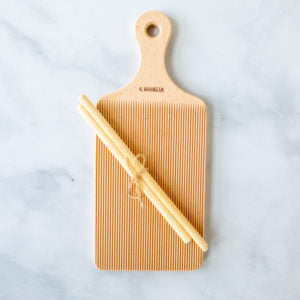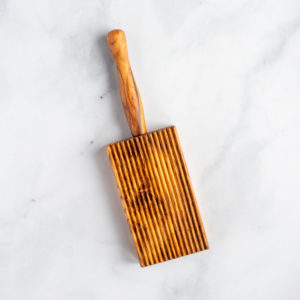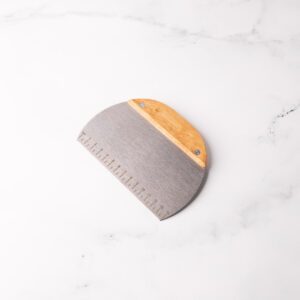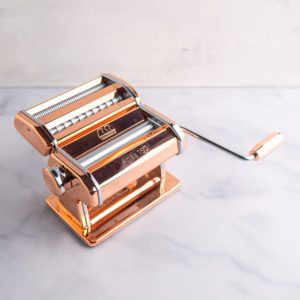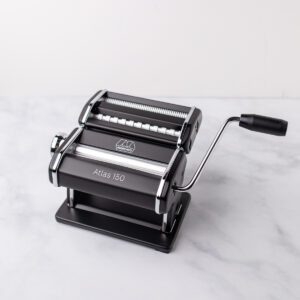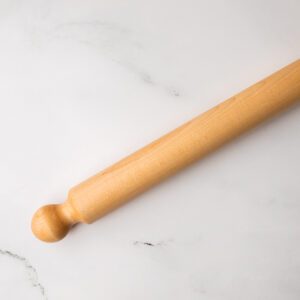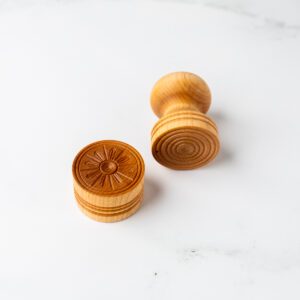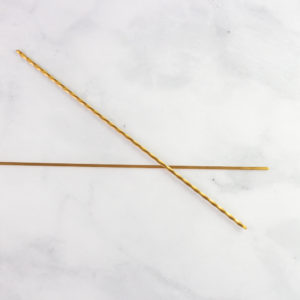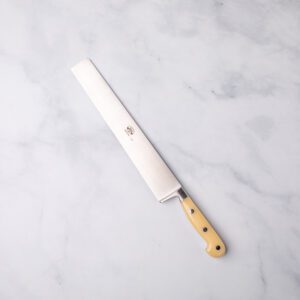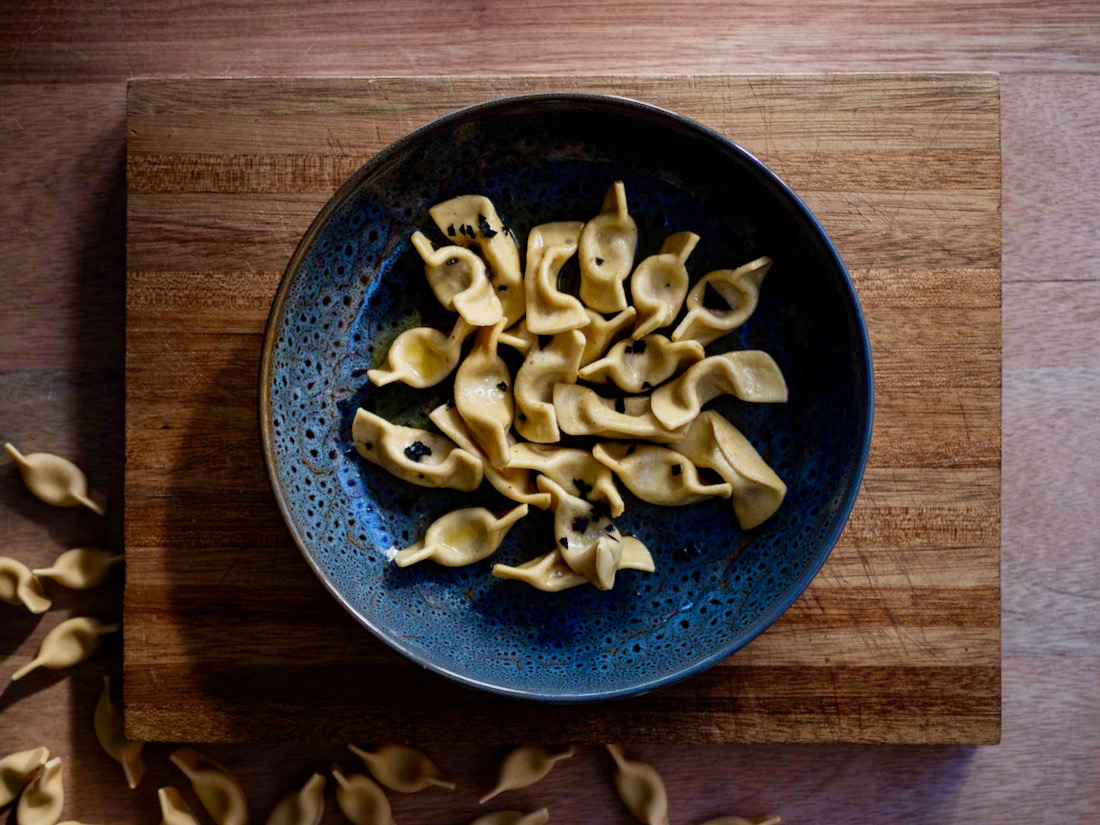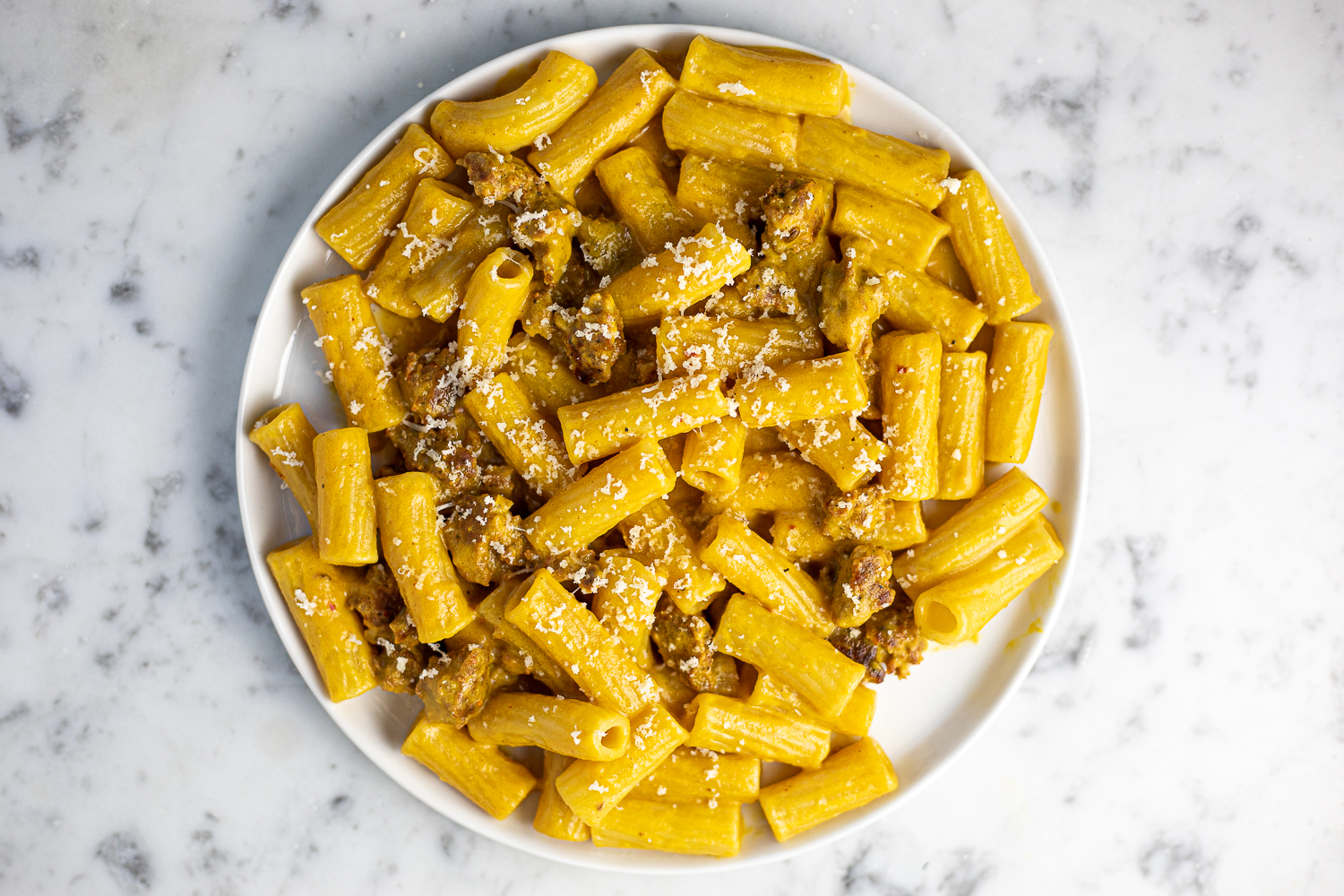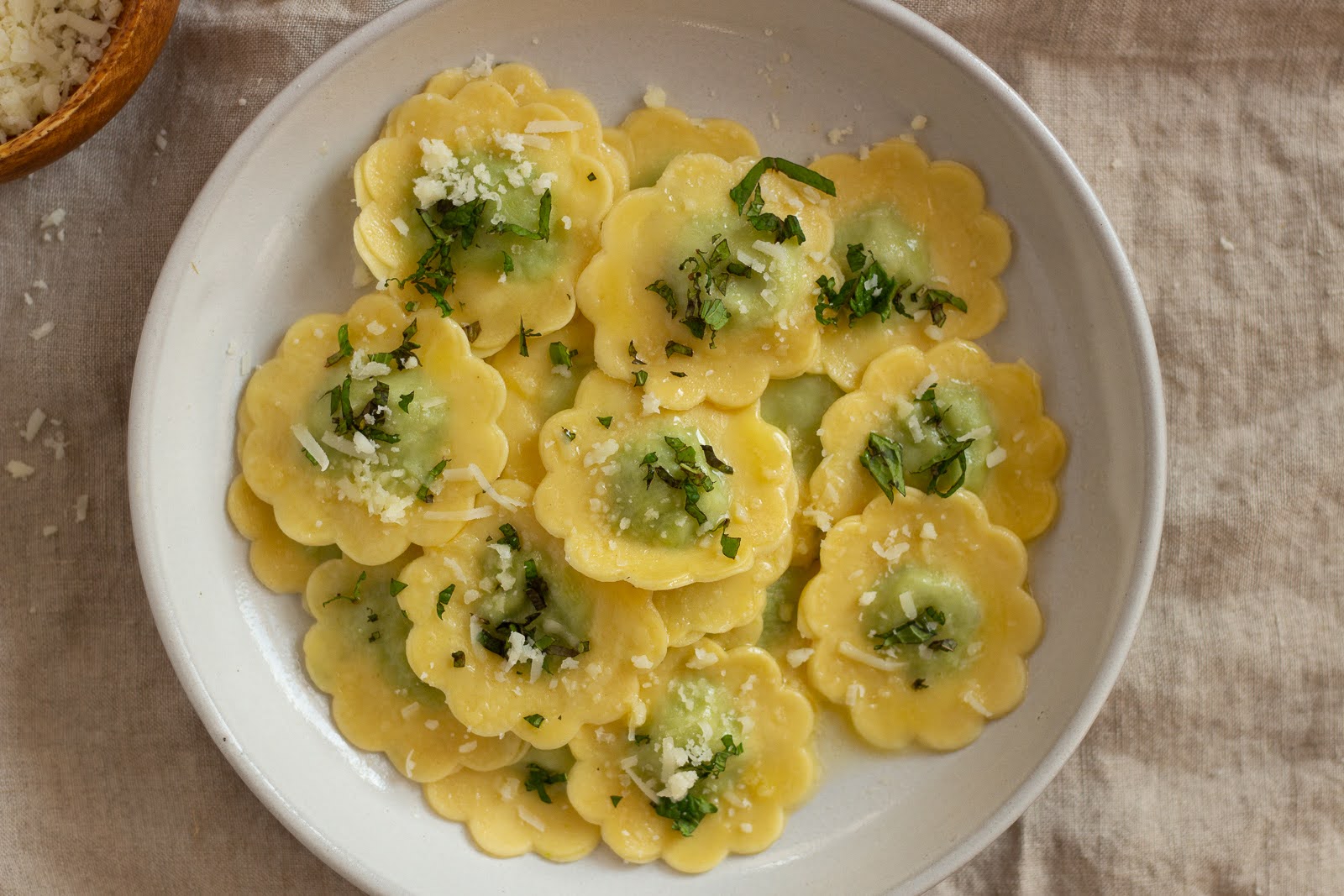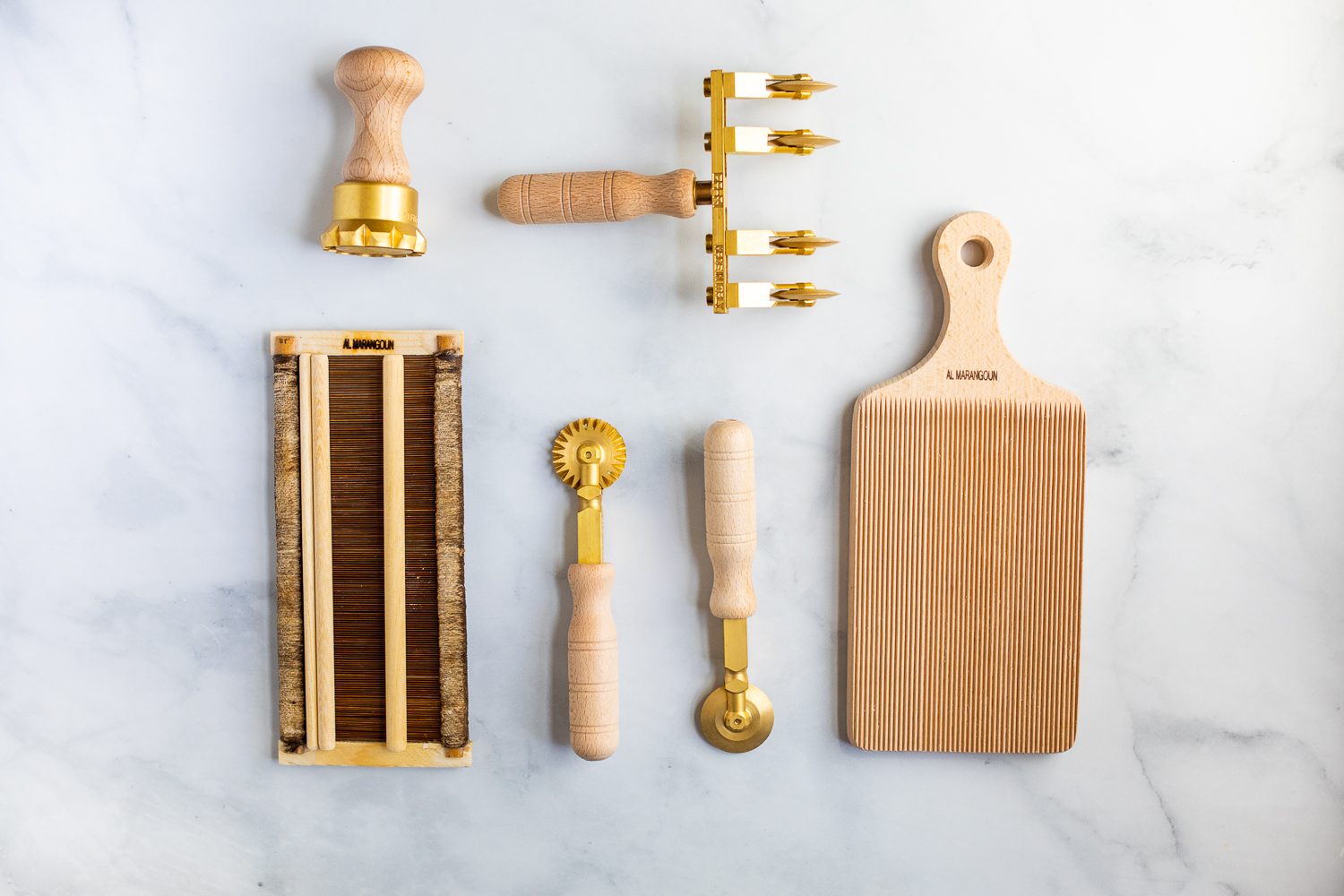
7 Essential Tools for Making Homemade Pasta Like a True Italian
When it comes to making fresh pasta at home, there are a few basic tools you’ll need in your kitchen arsenal.
Can you make pasta without these items? Sure, you could do without (and if that’s your style, we tip our hats to you). But if you’re getting serious about pasta making, all we can say is this: these tools are workhorses, and are going to quickly become your best friends come pasta time.
And just in case you don’t believe us, we invite you to watch any one of the Pasta Grannies videos. You’ll likely spot an Italian nonna rolling out her dough using some version of these gadgets!
1. Pasta Wheel
One of the best ways to cut out fresh egg pasta is to use a rotella per la pasta, or pasta wheel. Think: a mini pizza cutter. Using a wheel instead of a knife allows you to cut a straight edge in one swift movement. Plus, many pasta wheels also come with decorative fluted edges or have multiple wheels making it easier to cut out ribbons or squares all at once.
What shapes can you make with a pasta wheel? A single wheel will allow you to cut out lasagne, mafaldine, pappardelle, and more. With a multi-wheel pasta cutter, you can create squares and rectangles to serve as the base for just about any stuffed pasta shape, from tortellini to ravioli. If you have a fluted wheel, you can add a decorative zig-zag edge to just about any shape! It’s especially great for farfalle.
Check out our variety of brass and wood pasta wheels.
2. Wooden Pastry Board
Although marble and granite countertops make for gorgeous pasta pics, those kinds of surfaces aren’t ideal for making fresh pasta (but we still envy you if your kitchen has these!). Instead, a large untreated wooden pastry board is ideal for a few good reasons.
Ever watched a nonna roll out pasta? You’ll notice that she almost always does it on a wooden surface. This isn’t for the “rustic look.” It’s because the warmth and the grain of the wood impart a special texture on pasta.
While a regular cutting board will work in a pinch, we don’t recommend it for regular pasta-making use since it can sometimes hold unwanted residues from other foods that can seep into your pasta. Also, the incisions caused by knife cutting leave “scars” on cutting boards board where pasta dough can creep into. Our rule of thumb: keep your pasta on a pasta board and your meat and veggies on their own respective cutting surfaces!
And finally, having a separate wooden board that you can move around gives you much more flexibility in the kitchen. This is particularly helpful if you have a small kitchen where every inch of counter space counts. You make your pasta on your wooden board, then shift the whole thing to the dining table, freeing up counter space to prep your sauce!
We particularly love our reversible maple wooden pastry board. You don’t even need to use soap and water to clean this – untreated wood can be cleaned with a simple, hearty scrape to remove any flour that’s caked onto the surface. If you must, we’ve heard from an Italian mother or two that a simple scrub with baking soda, water, and a bit of lemon rind is a natural way to clean your board and rid it of any odor.
Wooden Pasta Board
3. Ridged Gnocchi Board
Good pasta is all about the texture! Adding ridges and grooves to the surface area of your pasta not only adds a beautiful look to your noodles but also creates highly functionally, sauce-capturing crannies.
An easy way to achieve this kind of texture is using a gnocchi board. With this simple tool, you can make homemade gnocchi, cavatelli, garganelli, and more! A gnocchi board is an affordable tool that’s perfect for even the most beginner pasta makers, especially because shapes like gnocchi and cavatelli rely on very little other special equipment.
4. Bench Scraper
When making pasta, things can get messy: dough can stick to your work surface and flour may go all over the place. But with a sturdy bench scraper, you can scoop things into place in one fell swoop. And if dough starts sticking to your board, all you have to do is scrape it off with the scraper.
Bench scrapers also come in handy when you’re cutting dough into smaller pieces. Although you could also use a knife for this, we find that a pastry scraper is slightly more comfortable and effective at getting a clean cut.
Having a bench scraper is especially important for keeping your wooden surface clean! We can’t stress this enough: it’s imperative to scrape off any leftover dried bits of dough throughout the pasta-making process to prevent them from getting into your soft and smooth dough. Those dried bits can cause the dough to tear when rolling it out and leave an unwanted texture.
We love our half-moon pasta bench scraper, which also functions as a ruler! It’s great for keeping a consistent cut size on certain pasta shapes.
5. Handcranked Pasta Machine
It sounds scarier than it really is!
A hand-cranked machine is essential if you’re looking to get into fresh egg pasta making. This simple machine attaches to your countertop or table and comes with a hand crank that helps push the pasta dough through a sort of press. You can adjust the press to create different thicknesses, allowing you to control how thin or thick you want your sheet of pasta dough to be. Most pasta machines come with 1-6 or 1-8 thickness settings.
There are many different pasta machines out there, but we’re particularly in love with the Copper Marcato Atlas 150, which comes with ten different pasta sheet thickness settings as well as a fettuccine and tagliolini attachment.
6. Italian Rolling Pin
Want to go the true pasta grannies route?
According to Vicky Bennison, author and creator of Pasta Grannies, almost every pasta granny has a mattarello, or rolling pin, in their kitchen. These rolling pins are typically at least 36 inches long (it needs to be long enough to handle the width of a thin sheet of pasta dough) and roughly 1-2 inches thick in diameter. It’s typically made of a hardwood, like beechwood, which is less susceptible to warping. The weight of the pin also helps apply pressure to the dough when rolling it out.
Mastering the art of hand-rolled pasta can take some time and it’s a technique that’s not for everyone. Some folks (Vicky included!) argue that using a pasta rolling pin is faster and easier than using a machine, because you don’t need to set up the machine and you can roll out the dough in one go (with machines, you have to roll out small pieces at a time). And there are some pasta types of pasta that are better done with a matterello. This is typically the case for pastas from Emilia-Romagna, like hand-cut tagliatelle, tortellini, and sfoglia lorda.
Ultimately, the decision between buying a pasta machine and buying an Italian rolling pin is simply a matter of preference. If you’re looking to learn how to use an Italian rolling pin, we recommend checking out the explanation in Marcella Hazan’s Essentials of Classic Italian Cooking book and watching Yummy Italy’s video on the rolling pin method.
7. Fine Mist Spray Bottle
Sometimes you need to add a little extra moisture to your pasta dough. This is particularly important when making shapes that need to be sealed together, such as tortellini, tortelloni, and garganelli.
Once sheeted and exposed to air, pasta can dry out quickly! An easy way to rehydrate the dough is to use a fine mist spray bottle. This simple tool helps apply a thin, even layer of moisture without completely dousing the dough, which would cause it to become too gooey.
Simply add lukewarm water to a clean spray bottle. Make sure the nozzle is set to a fine mist, then spray horizontally over the sheet of dough, letting the mist “drop” like rain rather than spraying it directly.
Post a Comment
You must be logged in to post a comment.


